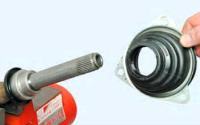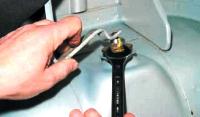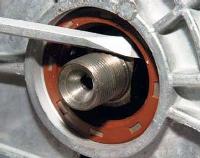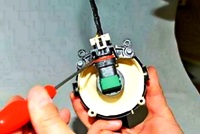Refrigerant drain
Because the air conditioning circuit is equipped with only one filling valve, some filling stations use only high pressure pipe
In some cases, let the system run for a few minutes before draining the refrigerant to ensure complete draining.
When draining the refrigerant or checking the charge of the refrigeration circuit, three cases must be taken into account:
- - The engine and air conditioning are running;
- - The engine is running, but the air conditioner is not working;
- - The engine and air conditioner are not working.
Engine and A/C running
Let the air conditioner run until the engine cooling fan turns on twice, then stop the engine.
Perform the first drain of the refrigerant (measure its drained amount), wait 15 minutes.
Check if relative pressure is less than or equal to 0 bar, restart drain cycles if pressure is not less than or equal to 0 bar.
Sum the amount of refrigerant drained from all cycles.
Charging is considered sufficient if the amount received is +35g or -100g from the nominal value.

The engine is running, but the air conditioner is not working
Let the engine run until the cooling fan turns on twice, then stop the engine.
Perform the first drain of the refrigerant (measure its drained amount), wait 15 minutes.
Let the engine run until the electric fan of the cooling system turns on twice, drain the coolant a second time (measure its drained amount).
Restart drain cycles if pressure is not less than or equal to 0 bar.
Sum the amounts of refrigerant drained from all cycles.
Charging is considered sufficient if the amount received is +35 gr. or -100 gr. from the nominal value.
Engine and A/C not working
Perform the first refrigerant drain
Engine and A/C not running.), please wait 2 hours
Restart drain cycles if pressure is not less than or equal to 0 bar.
Sum the amounts of refrigerant drained from all cycles.
Charging is considered sufficient if the amount received is +35 gr. or -100 gr. from the nominal value.
Search for leaks
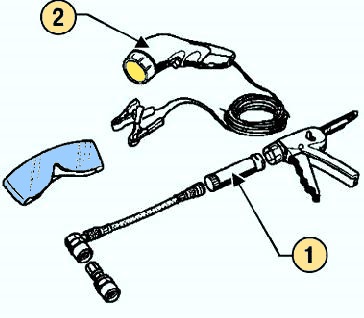
Leaks are detected using a contrast agent supplied in single-use capsules, and traces of leaks are detected using an ultraviolet lamp (Fig. 2).
The contrast agent remains in the air conditioning system. Using an ultraviolet lamp, you can check the condition of the refrigeration circuit.
If there are characteristic fluorescent traces, it is forbidden to inject a contrast agent into the refrigeration circuit.
Inject a dose of contrast agent if there are no characteristic fluorescent traces and a warning label (about the use of contrast agent in the past).
Introduction of a contrast agent into the contour.
Install the contrast medium injection system on the low pressure valve, 3 on vehicles with a single valve.
Inject the contrast medium into the contour.
Turn on the air conditioner and let it run for about 15 minutes.
Leak Detection Procedure
Perform a preliminary check (with the engine off) by running a UV lamp over the refrigeration circuit.
If there are no leaks:
- – carefully clean the external surfaces of the parts of the refrigeration circuit,
- - turn on the air conditioning compressor and do not turn it off until the location of the refrigerant leak is determined enent (if unsuccessful, check the status of the evaporator).
After using a contrast agent, be sure to indicate on the warning label (supplied with the contrast agent capsule) the fact of its use and the date of the operation.
The label must be affixed in a visible place near the filling valves of the refrigeration circuit (on the shock absorber support cup).






